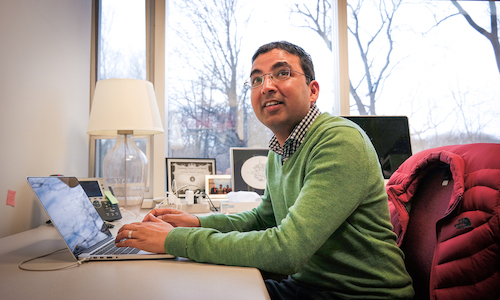
One of the reasons Associate Professor of Mathematics Mahesh Agarwal is so optimistic about the digital revolution now happening in higher education is that he considers himself a living testimonial. This is a guy, after all, who a few years ago used MOOCs—massive open online courses—offered by Stanford and others to teach himself computer programming.
In fact, he got so much out of it, it left him eager to experience life from the other side of the online classroom. He wasn’t shy about his choice of courses he wanted to teach either. The class he pitched to his department for a digital offering was the demanding linear algebra course.
“There’s a perception out there that you can’t teach math online,” Agarwal said. “Mathematics courses, in general, have the highest drop and fail rates. So the thought is that you can’t outsource this part of learning to the students. But I didn’t see it that way.”
To design his own course, Agarwal called on the things that worked best for him as a student: participatory exercises that provided feedback along the way; an engaging discussion community where “basically any question you could think of could get answered”; and the backbone of many online courses—polished, professionally recorded lectures.
“This wasn’t something I just shot in my basement on my laptop,” Agarwal said, laughing. “I went to the [U-M Office of Academic Innovation] studio in Ann Arbor, where they record their MOOCs. It’s impossible for me to be more thankful. The staff over there know all the little things—like when to do picture-in-picture, when to show a slide, how to simplify the post-production. It really is an art form.”
Agarwal also added a few touches of his own. He had seen research that some students learn better from their peers, so he enlisted an enthusiastic undergraduate student to record supplemental video tutorials. And when he noticed that students weren’t picking up their graded tests (the one offline component of the course), he added a program that allowed him to easily scan exams so they wouldn’t miss out on valuable feedback.
The platforms Agarwal used to build his course also had powerful learning analytics, including tools that helped him monitor whether the video lectures he painstakingly designed were actually connecting.
“For example, the system lets you see what the drop-off rate is in the video lecture, or where the students stop paying attention. That tells you either you’ve got the attention span wrong, or you have an idea that’s too complex for them to understand,” he said. “That’s a signal to me that I need to reinforce an idea or redo something in the video lecture.”
That’s something he does often in this semester’s “flipped” version of the linear algebra course. In this hybrid setting, students watch the lectures beforehand, and then use class time for exercises and deeper dives into tough concepts. Given how things are going so far, Agarwal said he’s “very, very confident” he’ll see much better results in his flipped class. Students in his original online course already showed they could hang academically with their offline classmates.
For Agarwal, it’s evidence that even difficult classes can be taught online—though he doesn’t necessarily think all classes are the best fit for this format.
“I think the best model, in many cases, is actually some kind of blend,” Agarwal said. “I think the one thing to avoid is using canned learning products. If that’s all you have to offer, students will start questioning the value of what we are bringing to the table. But it’s clear—if we get the blend right—that digital education can change student experiences in a very significant way.”



